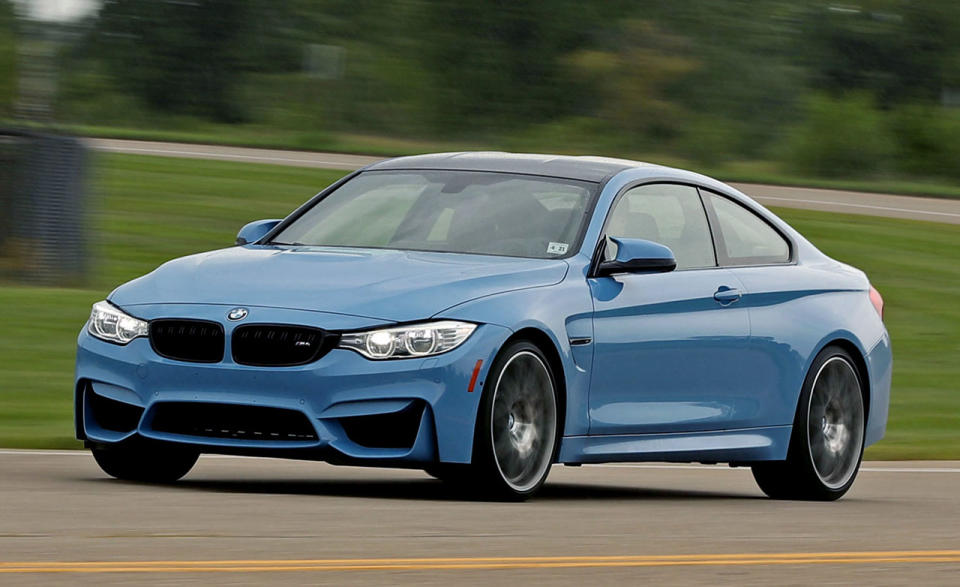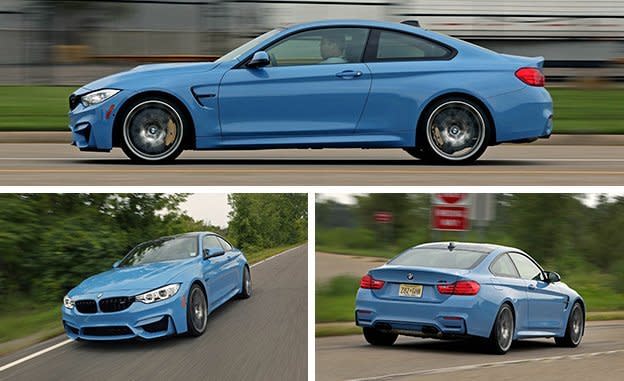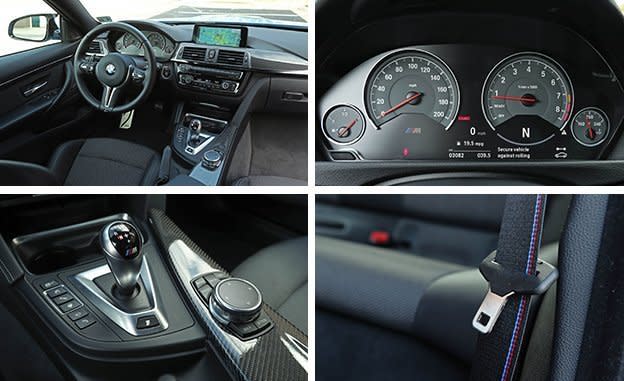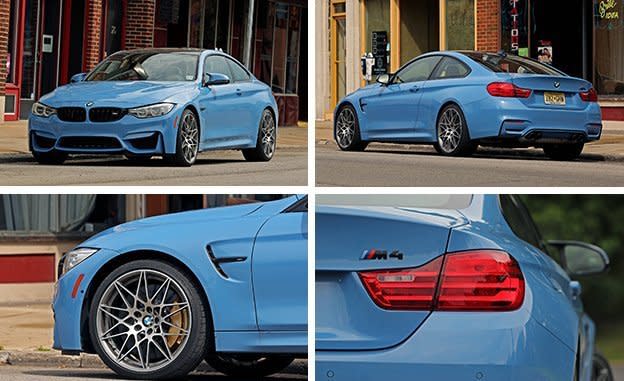2016 BMW M4 Coupe DCT Competition Package

By now BMW’s F30 M4 is a known quantity, being an über-quick German sports coupe revered for its performance and chastised for not being as tactile as its much-loved predecessor, the E92 M3 coupe. The M4 gets dinged for its twin-turbocharged inline-six that can’t match the sheer screaming joy of winding out the old M3’s naturally aspirated V-8 to its 8300-rpm limit, for its numb steering, and for its generally overdigitized nature. None of these transgressions keep the M4 from posting incredible performance numbers, but they do sap some of the fun from the process of extracting them.
If the M4 is old news, the $5500 Competition package that BMW released for 2016 is new news. (Even newer news is that the 2017 package price has dropped to $4750 for the coupe and $4250 for the convertible.) Available on both the M4 and the M3 sedan, the kit includes the optional M Adaptive suspension dampers (albeit with revised tuning), stiffer springs, blacked-out exterior trim and badges, a 19-hp bump, a substantially louder exhaust, wider tires on 20-inch wheels similar to those on the limited-production M4 GTS, and the same lightweight seats as the GTS. As you could reasonably expect from an option bundle with “competition” in its name, the Competition package intends to broaden the M4’s performance envelope.
Well, not so fast.

Literally, Not So Fast
Despite juicing the M4’s mighty 3.0-liter twin-turbocharged inline-six by 19 horsepower to 444, the Competition package fails to put any extra spring in the coupe’s step. Our test car came equipped with the optional seven-speed dual-clutch automatic, and its 3.8-second zero-to-60-mph time fell between the times posted by two other DCT-equipped M4s we’ve tested. The extra power, added at the top of the rev range, doesn’t help straight-line acceleration much, and the 19 ponies’ effect isn’t noticeable from behind the wheel. Additionally, the tester noted that the dual-clutch’s launch-control function didn’t seem to be as effective as the previous examples’ and the M4 struggled with launch grip.
Expectations of greater lateral grip from the wider-than-stock Michelin Pilot Super Sport tires (265/30 front, 285/30 rear) and stiffened suspension similarly went unmet. The Competition-package car recorded 0.99 g on our skidpad—0.01 g less than the best figure we’ve gotten from a regular M4 and only 0.05 g better than the worst figure we have on file from the lineup, that being from an M4 convertible.

Our test car also came equipped with BMW’s $8150 carbon-ceramic brakes, and while they aren’t required if the Competition package is selected, their promise of fade-free operation under extreme circumstances—say, on a racetrack—make them a natural addition. Except here, too, our expectations were unmet: Our car’s admittedly impressive 151-foot stopping distance from 70 mph was no better than those recorded by other M4s we’ve tested (also fitted with carbon-ceramic discs), and we noticed some brake fade, something that didn’t occur in those other M4s. Also, just as we’ve experienced in other BMWs so equipped, the carbon-ceramic brakes also have the alarming tendency to go unresponsive during the first pump of the brake pedal in wet weather. Extra pumps restore the binders’ responsiveness—as noted in the owner’s manual—but it’s a discomforting trait nevertheless.
Subjective Measurements
If the Competition package fails to light a little fire under the M4’s already hot objective performance figures, it has far greater effect on the coupe’s subjective performance. There’s slightly more information coming up through the steering wheel to the driver’s hands, partly nullifying one of our biggest complaints about the regular M4, its lifeless steering.
There’s no overlooking BMW’s noodling with the M Adaptive suspension’s adjustable dampers and fitment of 15-percent-firmer springs front and rear. That’s because each of the three driver-selectable settings are a notch firmer relative to the already stiff M4. The Competition model’s Comfort mode rides like the Sport mode in a regular M4, while the Sport setting matches up with the M4’s Sport+, and Sport+ moves the Competition model somewhere just past “granite” on the hardness scale. We left the M4 in its softest Comfort mode for most of our time with the car, which besides relieving our vertebrae minimized the susceptibility to skip over midcorner bumps, upsetting the chassis.

If there’s a silver lining to the rock-hard ride, it’s that it keeps the regular M4’s overly digitized experience at bay, despite myriad settings for the steering effort, throttle sensitivity, shift speed, shift algorithm, and suspension damping. After all, it certainly doesn’t feel like the computers are doing much every time one of the Competition package’s gorgeous 20-inch wheels slams over a pothole, no matter which drive mode is selected. Talk about analog.
At this point we could step away from the tit-for-tat, merit-based discussion of the Competition package’s effect on the M4 by throwing a Chevrolet Corvette Grand Sport–shaped wrench into things. The track-oriented Vette is similarly priced but offers more cornering grip, equivalent acceleration, and more general tactility than the BMW.
For those with their hearts set on an M4, however, the Competition package’s price-to-content ratio is hugely favorable, and if you can tolerate the ride quality or live somewhere with glass-smooth roads, the kit is worth it for the extra steering feel and those delectable wheels. The raspier exhaust note (which unlike the regular M4’s is audible over the artificial engine noise piped in via cabin speakers) is purely a bonus. Just do yourself a favor and stick with a lower-spec car than our $89,995 test example. The $3200 Executive package (heated steering wheel, backup camera, retractable headlight washers, parking sensors, and a head-up display), $1900 Lighting package (automatic high-beams), $750 360-degree parking cameras, $350 “Enhanced Bluetooth,” and $550 Yas Marina Blue paint did little for the M4’s competitiveness but inflated the price far beyond the $72,195 minimum required for a Competition package model with a manual transmission.
Specifications >
VEHICLE TYPE: front-engine, rear-wheel-drive, 4-passenger, 2-door coupe
PRICE AS TESTED: $89,995 (base price: $74,845)
ENGINE TYPE: twin-turbocharged and intercooled DOHC 24-valve inline-6, aluminum block and head, direct fuel injection
Displacement: 182 cu in, 2979 cc
Power: 444 hp @ 7000 rpm
Torque: 406 lb-ft @ 1850 rpm
TRANSMISSION: 7-speed dual-clutch automatic with manual shifting mode
DIMENSIONS:
Wheelbase: 110.7 in
Length: 184.5 in
Width: 73.6 in Height: 54.4 in
Passenger volume: 90 cu ft
Cargo volume: 11 cu ft
Curb weight: 3645 lb
C/D TEST RESULTS:
Zero to 60 mph: 3.8 sec
Zero to 100 mph: 8.6 sec
Zero to 130 mph: 14.8 sec
Zero to 150 mph: 21.9 sec
Rolling start, 5–60 mph: 4.4 sec
Top gear, 30–50 mph: 2.2 sec
Top gear, 50–70 mph: 2.9 sec
Standing ¼-mile: 12.1 sec @ 119 mph
Top speed (governor limited): 163 mph
Braking, 70–0 mph: 151 ft
Roadholding, 300-ft-dia skidpad: 0.99 g
FUEL ECONOMY:
EPA city/highway driving: 17/24 mpg
C/D observed: 20 mpg
C/D observed 75-mph highway driving: 27 mpg
C/D observed highway range: 420 mi

 Yahoo Autos
Yahoo Autos 